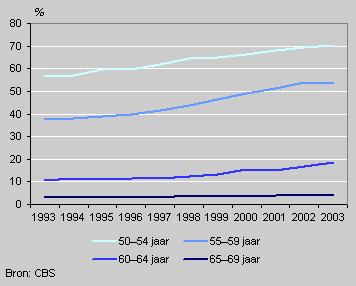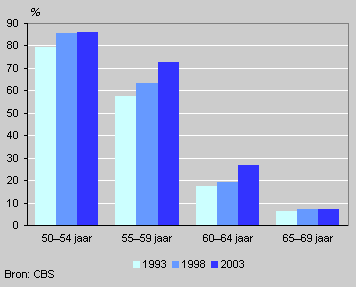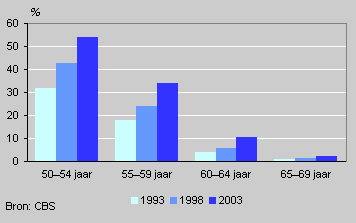Older people working more

In the period 1993–2003 the labour participation of people over 50 increased substantially. Labour participation increased more among women than among men over 50. The labour participation rate in the 60–64 age bracket nearly doubled. Among people over 65, labour participation remained low.
Almost a fifth of people aged 60–64 work
In 2003 seven in ten people aged 50–54 had a paid job. For people aged 55–59 labour participation was substantially lower with five in ten. But the largest decrease in the labour participation rate is found among people over 60. Fewer than two in ten people in the age group 60–64 work, while there is hardly anyone over 65 with a paid job anymore. Only 5 percent of the group was still working.
Labour participation of people over 50

Largest increase among 55–59 year olds
Labour participation among older people increased over the last decade in all age groups. More people aged 55–59 have paid jobs. Their participation rate increased from 38 to 53 percent. In 2003 their labour participation did not increase any further, but this is due to the sharp increase in unemployment. However, when the entire employed and unemployed labour force is taken into account, there is still an increase in the participation rate of this age group.
Growing labour participation among men
Labour participation among men aged 55–59 increased substantially: from 57 percent in 1993 to 73 percent in 2003. Among men aged 60–64 the increase is also strong. Their labour participation rate increased from almost 18 to 27 percent in the period 1993–2003. The increase mostly occurred over the last five years and is because men stop working at a later age.
Labour participation of men aged 50–69

Greater increase in working women up to 60
The labour participation rate among women increased faster than among men, especially in the 50–54 age bracket. In 1993 less than one third of the women in this age group belonged to the employed labour force. In 2003 this had increased to 54 percent.
Labour participation of women aged 50–69

The labour participation rate among women also increased fastest in the age groups 55–59 and 60–64. The fact that the growth rate is higher among women than among men is because women of the younger generations want to have paid jobs more often. This cohort effect does not play a role among men.
Ingrid Beckers